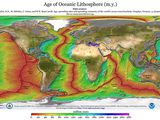Seafloor Spreading
Seafloor spreading is a geologic process in which tectonic plates—large slabs of Earth’s lithosphere—split apart from each other.
2Seafloor Spreading
For upon |Seafloor spreading is a geologic process in which tectonic plates—large slabs of Earth’s lithosphere—split apart from each other.
Ocean Floor
Learn more about ocean trenches, mid-ocean ridges, and other features of the seafloor with this Nat Geo video.
Mantle Convection
Seafloor spreading is a result of mantle convection. Mantle convection is the slow, churning motion of solid and molten material in Earth’s mantle. The two theories about how mantle convection works—the “layered mantle” and “whole mantle” hypotheses—are displayed on this diagram.
Seafloor Spreading
As magma bubbles up at sites of seafloor spreading, it is cooled by frigid seawater and becomes Earth’s newest oceanic crust. Most of this new igneous rock is basalt, like this pillow lava that bubbled up at the East Pacific Rise near the Galapagos Islands.
Oceanic Crust
Seafloor spreading helps create mid-ocean ridges, giant underwater mountain ranges that develop where tectonic activity is driving plates apart from each other. This lovely map highlights where tectonic plates are separating at mid-ocean ridges.
East Pacific Rise
Mid-ocean ridges circle the globe like “seams on a baseball,” according to NASA. Islands, such as Iceland (part of the Mid-Atlantic Ridge) and these islands off the southwest coast of Mexico are part of those “seams.”
Iceland’s the Mid-Atlantic Ridge
Slow-spreading centers have steep cliffs and plunging ocean trenches. This rocky outcrop is part of the slow-spreading Mid-Atlantic Ridge, which is just above sea level on the island of Iceland. To the left is the eastern edge of the North American continent. On the right is the western edge of Eurasia. (Fast spreading centers, such as the East Pacific Rise, have more gentle slopes and lack deep trenches.)
Passive Margins
The oceanic crust becomes thicker and denser as it moves away from the spreading center. As it reaches a continental boundary, it encounters either an active plate margin (a convergent boundary where an oceanic plate crashes into a continental plate) or a passive plate margin (where a single tectonic plate transitions from the oceanic crust to the continental crust). In this map of passive plate margins, note that seafloor created at the Mid-Atlantic Ridge will ultimately encounter passive plate margins, while seafloor created at the East Pacific Rise will likely encounter a subduction zone near the coast of South America—the site of (very) active plate boundaries.
Red Sea
As seafloor spreading rends tectonic plates from each other, it can create new ocean basins—such as the Red Sea, which was created as the African and Asian plates were torn apart over millions of years. Today, the triangle-shaped Sinai Peninsula (at the top of this beautiful NASA image) links the two continents. Eventually, Africa and Asia will split entirely and the Mediterranean and Red Seas will merge.
Mid-Ocean Ridges
Geomagnetic Reversals
Keeping Earth in Shape

Earth’s newest crust is created at sites of seafloor spreading—red sites on this map.
Map courtesy NOAA


Comments are closed.